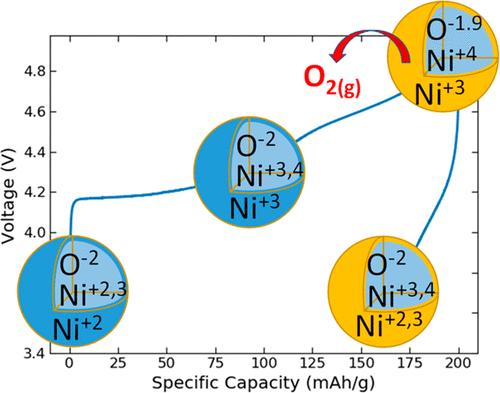当前位置:
X-MOL 学术
›
Chem. Mater.
›
论文详情
Our official English website, www.x-mol.net, welcomes your feedback! (Note: you will need to create a separate account there.)
Impact of Nickel Substitution into Model Li-Rich Oxide Cathode Materials for Li-Ion Batteries
Chemistry of Materials ( IF 8.6 ) Pub Date : 2020-01-08 , DOI: 10.1021/acs.chemmater.9b04446 Michelle Ting 1 , Matthew Burigana 1 , Leiting Zhang 2 , Y. Zou Finfrock 3 , Sigita Trabesinger 2 , Antranik Jonderian 1 , Eric McCalla 1
Chemistry of Materials ( IF 8.6 ) Pub Date : 2020-01-08 , DOI: 10.1021/acs.chemmater.9b04446 Michelle Ting 1 , Matthew Burigana 1 , Leiting Zhang 2 , Y. Zou Finfrock 3 , Sigita Trabesinger 2 , Antranik Jonderian 1 , Eric McCalla 1
Affiliation

|
Developments in lithium-ion batteries for energy storage are currently focused on improving energy density, increase cycle life, and reducing cost to match targets set by the automotive industry. An important class of cathodes, known as Li-rich layered oxides, Li–Ni–Mn–Co–O, is considered promising for next-generation electrode materials, yet a poor understanding of a number of detrimental processes, for which the underlying mechanisms are not clear, has hindered their commercialization. Numerous model systems have been studied in an effort to fully understand the discrete mechanisms taking place during battery operation. Given that Ni is relied upon more and more in commercial materials, we build here upon the previous work on model systems by studying Li–Ni–Sb–O and Li–Ni–Te–O materials to better understand the impact of Ni substitution into this complex class of materials. Using a combination of detailed electrochemical tests, X-ray diffraction, online electrochemical mass spectrometry, X-ray absorption near-edge spectroscopy, and X-ray photoemission spectroscopy, we find a stark contrast between the electrochemistry taking place in the bulk of particles as compared to that taking place at the surface. We find that oxidation of oxygen results in reduction of nickel, as was seen previously in Li–Fe–Sb–O, and this has a detrimental impact on the discharge capacity. However, the reductive couple occurs solely at the surface of particles in Ni-containing materials because of mitigated oxygen gas production in these materials. The consequences of this contrast between the surface and the bulk are discussed to guide further development of next-generation electrodes.
中文翻译:

镍替代锂离子电池模型富锂氧化物正极材料的影响
储能锂离子电池的发展目前集中在提高能量密度,延长循环寿命和降低成本以符合汽车行业设定的目标。一类重要的阴极,称为富锂层状氧化物,Li-Ni-Mn-Co-O,被认为对下一代电极材料很有前途,但对许多有害过程的理解却不多,其潜在机理尚不清楚,阻碍了它们的商业化。为了充分理解电池运行过程中发生的离散机制,已经研究了许多模型系统。鉴于镍越来越多地用于商业材料,我们在此之前的模型系统研究基础上,通过研究Li-Ni-Sb-O和Li-Ni-Te-O材料来更好地理解镍替代对这种复杂材料类别的影响。通过将详细的电化学测试,X射线衍射,在线电化学质谱,X射线吸收近边缘光谱和X射线光发射光谱相结合,我们发现在大量颗粒中发生的电化学之间形成了鲜明的对比。与在地面上发生的情况相比。我们发现,氧的氧化会导致镍的还原,正如先前在Li–Fe–Sb–O中所见,这对放电容量有不利影响。然而,由于减少了这些材料中氧气的产生,还原偶仅出现在含镍材料中的颗粒表面。
更新日期:2020-01-08
中文翻译:

镍替代锂离子电池模型富锂氧化物正极材料的影响
储能锂离子电池的发展目前集中在提高能量密度,延长循环寿命和降低成本以符合汽车行业设定的目标。一类重要的阴极,称为富锂层状氧化物,Li-Ni-Mn-Co-O,被认为对下一代电极材料很有前途,但对许多有害过程的理解却不多,其潜在机理尚不清楚,阻碍了它们的商业化。为了充分理解电池运行过程中发生的离散机制,已经研究了许多模型系统。鉴于镍越来越多地用于商业材料,我们在此之前的模型系统研究基础上,通过研究Li-Ni-Sb-O和Li-Ni-Te-O材料来更好地理解镍替代对这种复杂材料类别的影响。通过将详细的电化学测试,X射线衍射,在线电化学质谱,X射线吸收近边缘光谱和X射线光发射光谱相结合,我们发现在大量颗粒中发生的电化学之间形成了鲜明的对比。与在地面上发生的情况相比。我们发现,氧的氧化会导致镍的还原,正如先前在Li–Fe–Sb–O中所见,这对放电容量有不利影响。然而,由于减少了这些材料中氧气的产生,还原偶仅出现在含镍材料中的颗粒表面。


























 京公网安备 11010802027423号
京公网安备 11010802027423号